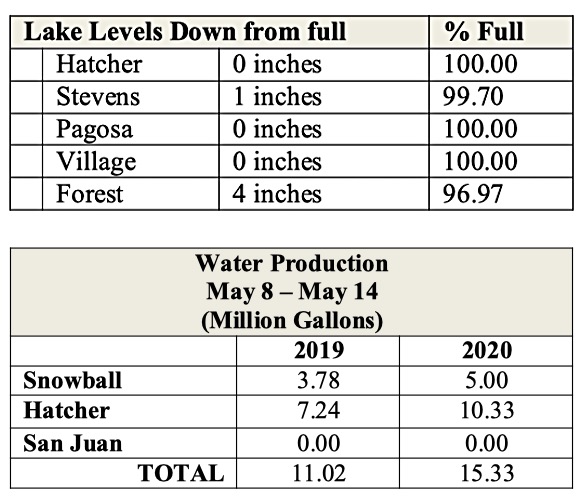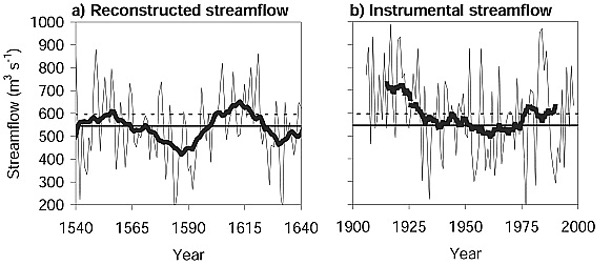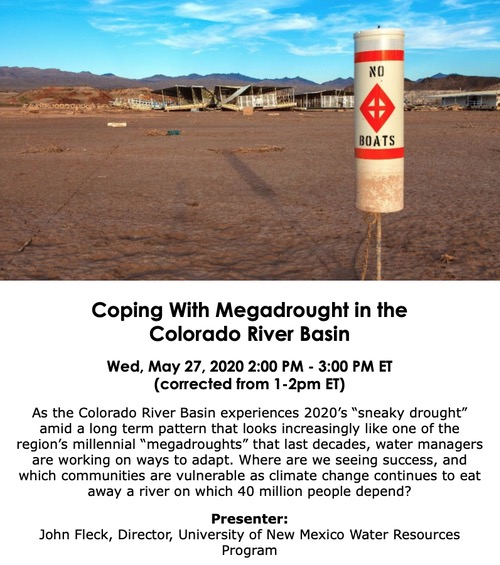Some water industry politicians would like us to feel a healthy fear about our drinking water.
As a member of the San Juan Water Conservancy District board of directors, I occasionally receive warnings about the dire situation we’re in, here in the American West, in terms of water supplies. Lately, some of the frantically waving red flags have been emblazoned with the term:
MEGADROUGHT
As the Colorado River Basin experiences 2020’s “sneaky drought” amid a long term pattern that looks increasingly like one of the region’s millennial “megadroughts” that last decades, water managers are working on ways to adapt. Where are we seeing success, and which communities are vulnerable as climate change continues to eat away a river on which 40 million people depend?
Apparently, Mother Nature has been especially “sneaky” this year, by giving us a mostly-normal snowpack in the Rocky Mountains, but then — drat! —delivering below-normal precipitation and some warmer-than-average spring temperatures. As we can easily see in the photograph attached to the “Coping with Megadrought” webinar email, above, our lakes and reservoirs in the American West have basically dried up, due to climate change. We’re right in the middle of a serious water shortage disaster.
But despite the dire “megadrought” warnings from water industry bureaucrats and scientists, the most recent report from our local water district — Pagosa Area Water and Sanitation District (PAWSD) — indicates that all of the water reservoirs in Archuleta County are completely full, or nearly so.
 The reservoirs are nearly all full, even though the reported production of PAWSD water is significantly higher than last year. Like, 35 percent higher?
The reservoirs are nearly all full, even though the reported production of PAWSD water is significantly higher than last year. Like, 35 percent higher?
The truth is difficult to get at, when we’re faced with apparently contradictory evidence. Are we really in the midst of a megadrought that will last for decades? Are we actually just wasting our limited water resources in a careless, devil-may-care manner?
Or both?
Years ago, when I was married, Clarissa and I often butted heads over financial matters. When we found ourselves bouncing checks and sweating over the mortgage payments, we had two very different ideas about how to solve the problem. Clarissa’s idea was that we needed to make more money. My idea was that we needed to spend less money. Both approaches were, of course, feasible — although to my mind, it was considerably easier to spend less than to make more. ‘Making more money’ implied additional work, something to which I have always had an aversion. But ‘spending less’ implied a change in the standard of living to which Clarissa had become accustomed.
A similar conflict can be seen in the approaches taken by various water industry politicians, except that there is really no way to ‘make more water.’ But it’s possible to stash whatever water Nature provides into larger and ever-more-expensive water reservoirs.
Or alternatively, we could ‘spend less.’
The term ‘drought’ — or ‘megadrought’ as is preferred by certain water industry politicians in 2020 — typically gets tied to the idea of climate change, and to the idea of ‘deficiency.’ But ‘drought’ can also be seen in terms of ‘poor planning’ in the same way bounced checks can be seen in terms of ‘poor planning.’ A drought has meaning (to humans) only in terms of ‘the amount of water to which we are accustomed, to do all the things we want to do with it.’
Here’s an interesting chart I found in a 2004 study of water availability in the American West, looking at ‘megadroughts.’ It was published on the American Geological Union (AGU) website. The chart on the left shows the streamflows in three major Western rivers — the Colorado, the Sacramento, and the Yellowstone — as reconstructed from tree ring studies — from 1540 until 1640.
The chart on the right shows the same three rivers, scientifically measured by instruments (stream gauges) during a more recent century, 1900-2000.
 The dark line running through each chart is a 20-year running average.
The dark line running through each chart is a 20-year running average.
The solid horizontal line represents the long‐term ‘mean’ of the streamflow reconstruction (1549-1640), and the dashed line represent the mean of the instrumental records (1900-2000).
As we can see, during the century 1540-1640 — prior to any ‘climate change’ problems — the combined streamflows averaged about 550 cubic meters per second. Around the year 1580, the 20-year running average dropped as low as about 400 cubic meters per second, and in 1615, the flows were much higher, around 650 cubic meters per second. This might be accurate numbers, but we will remind ourselves that it’s reconstructed from tree ring data.
At any rate, it would appear that the American West experienced a significant 45-year ‘drought’ between 1560 and 1605. A ‘megadrought’?
Then we come into the start of the 20th century, as the world begins to pump massive amounts of carbon dioxide into the atmosphere. The 20-year running average starts off at about 750 cubic meters per second… never gets below 500 cubic meters per second… and then heads back upwards. The mean streamflow in the American West is about 600 cubic meters per second… significantly higher than the number (550) calculated between 1540 and 1640.
We are now 20 years into the 21st century, and we are warned of a ‘megadrought’ due to the unmitigated release of carbon dioxide — a release that, apparently, had no perceivable effect on water availability in the American West during the previous 100 years, as calculated by AGU scientists.
But as I may have indicated already, the idea of drought is not merely a matter of ‘the amount of available water’. It also depends on ‘the amount of water we wish we had.’
Back in Part Two, yesterday, we noted that agricultural uses account for about 94 percent of all water used in Archuleta County, according to US Geological Survey data. Most of that agricultural water is protected by ‘senior water rights’ under Colorado Water Law, and almost none of it is supplied by any of our three local water districts.
Does the community, as a whole, draw significant benefits from the 15.3 billion gallons of water used each year by our local agricultural industry? That might be an interesting question to explore.


